This information is based on information provided by the Energy Efficiency and Renewable Energy Clearinghouse at the U.S. Department of Energy.
From Types to Coils to Efficiency…
More than You Want to Know About Energy-Efficient Air Conditioning
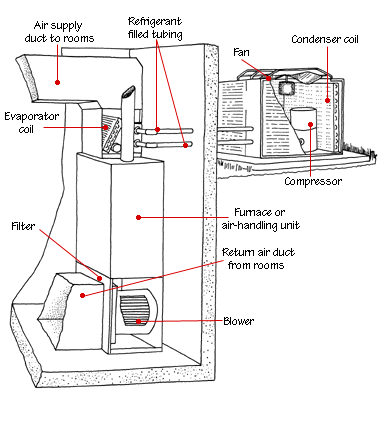
Are you considering buying a new air conditioner? Or, are you dissatisfied with the operation of your current air conditioner? Are you unsure whether to fix or replace it? Are you concerned about high summer utility bills? If you answered yes to any of these questions, read on.
In this article, you can learn about various types of air conditioning systems and how to maintain your air conditioner, hire professional air conditioning services, select a new air conditioner, and ensure that your new air conditioner is properly installed.
Many people buy or use air conditioners without understanding their designs, components and operating principles. Proper sizing, selection, installation, maintenance and correct use are keys to cost-effective operation and lower overall costs.
How Air Conditioners Work
Air conditioners employ the same operating principles and basic components as your home refrigerator. An air conditioner cools your home with a cold indoor coil called the evaporator. The condenser, a hot outdoor coil, releases the collected heat outside. The evaporator and condenser coils are serpentine tubing surrounded by aluminum fins. This tubing is usually made of copper. A pump, called the compressor, moves a heat transfer fluid (or refrigerant) between the evaporator and the condenser. The pump forces the refrigerant through the circuit of tubing and fins in the coils. The liquid refrigerant evaporates in the indoor evaporator coil, pulling heat out of indoor air and thereby cooling the home. The hot refrigerant gas is pumped outdoors into the condenser where it reverts back to a liquid giving up its heat to the air flowing over the condenser's metal tubing and fins.
Types of Air Conditioners
The basic types of air conditioners are:
- room air conditioners,
- split-system central air conditioners, and
- packaged central air conditioners.
- Room Air Conditioners

cut-away diagram
Room air conditioners cool rooms rather than the entire home. If they provide cooling only where they're needed, room air conditioners are less expensive to operate than central units, even though their efficiency is generally lower than that of central air conditioners. Smaller room air conditioners — those drawing less than 7.5 amps of electricity — can be plugged into any 15- or 20-amp, 115-volt household circuit that is not shared with any other major appliances. Larger room air conditioners — those drawing more than 7.5 amps — need their own dedicated 115-volt circuit. The largest models require a dedicated 230-volt circuit.
- Central Air Conditioners
Central air conditioners circulate cool air through a system of supply and return ducts. Supply ducts and registers — openings in the walls, floors, or ceilings covered by grills — carry cooled air from the air conditioner to the home. This cooled air becomes warmer as it circulates through the home. Then it flows back to the central air conditioner through return ducts and registers. A central air conditioner is either a split-system unit or a packaged unit. In a split-system central air conditioner, an outdoor metal cabinet contains the condenser and compressor, and an indoor cabinet contains the evaporator. In many split-system air conditioners, this indoor cabinet also contains a furnace or the indoor part of a heat pump. The air conditioner's evaporator coil is installed in the cabinet or main supply duct of this furnace or heat pump.
If your home already has a furnace but no air conditioner, a split-system is the most economical central air conditioner to install. In a packaged central air conditioner, the evaporator, condenser, and compressor are all located in one cabinet, which usually is placed on a roof or on a concrete slab next to the house's foundation. This type of air conditioner also is used in small commercial buildings. Air supply and return ducts come from indoors through the home's exterior wall or roof to connect with the packaged air conditioner, which is usually located outdoors.
Packaged air conditioners often include electric heating coils or a natural gas furnace. This combination of air conditioner and central heater eliminates the need for a separate furnace indoors.
Maintaining Existing Air Conditioners
Older air conditioners may still be able to offer years of relatively efficient use. However, making your older air conditioner last requires you to perform proper operation and maintenance.
Air Conditioning Problems

central air conditioner
One of the most common air conditioning problems is improper operation. If your air conditioner is on, be sure to close your home's windows and outside doors. Other common problems with existing air conditioners result from faulty/improper installation, poor service procedures and inadequate maintenance.
Improper installation of your air conditioner can result in leaky ducts and low air flow.
Many times, the refrigerant charge — the amount of refrigerant in the system — does not match the manufacturer's specifications. If proper refrigerant charging is not performed during installation, the performance and efficiency of the unit is impaired. Service technicians often fail to find refrigerant charging problems or even worsen existing problems by adding refrigerant to a system that is already full.
Air conditioner manufacturers generally make rugged, high quality products.
If your air conditioner fails, it is usually for one of the common reasons listed below:
- refrigerant leaks. If your air conditioner is low on refrigerant, either it was undercharged at installation, or it leaks. If it leaks, simply adding refrigerant is not a solution. A trained technician should fix any leak, test the repair and then charge the system with the correct amount of refrigerant. Remember that the performance and efficiency of your air conditioner is greatest when the refrigerant charge exactly matches the manufacturer's specification, and is neither undercharged nor overcharged.
- inadequate maintenance. If you allow filters and air conditioning coils to become dirty, the air conditioner will not work properly, and the compressor or fans are likely to fail prematurely.
- electric control failure. The compressor and fan controls can wear out, especially when the air conditioner turns on and off frequently, as is common when a system is oversized. Because corrosion of wire and terminals is also a problem in many systems, electrical connections and contacts should be checked during a professional service call.
Regular Maintenance
An air conditioner's filters, coils and fins require regular maintenance for the unit to function effectively and efficiently throughout its years of service. Neglecting necessary maintenance ensures a steady decline in air conditioning performance while energy use steadily increases.
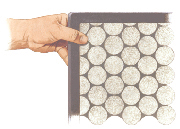
filter
- Air Conditioner Filters
The most important maintenance task that will ensure the efficiency of your air conditioner is to routinely replace or clean its filters. Clogged, dirty filters block normal air flow and reduce a system's efficiency significantly. With normal air flow obstructed, air that bypasses the filter may carry dirt directly into the evaporator coil and impair the coil's heat-absorbing capacity. Filters are located somewhere along the return duct's length. Common filter locations are in walls, ceilings, furnaces, or in the air conditioner itself. Some types of filters are reusable; others must be replaced. They are available in a variety of types and efficiencies. Clean or replace your air conditioning system's filter or filters every month or two during the cooling season. Filters may need more frequent attention if the air conditioner is in constant use, is subjected to dusty conditions, or you have fur-bearing pets in the house.
- Air Conditioner Coils
The air conditioner's evaporator coil and condenser coil collect dirt over their months and years of service. A clean filter prevents the evaporator coil from soiling quickly. In time, however, the evaporator coil will still collect dirt. This dirt reduces air flow and insulates the coil which reduces its ability to absorb heat. Therefore, your evaporator coil should be checked every year and cleaned as necessary. Outdoor condenser coils can also become very dirty if the outdoor environment is dusty or if there is foliage nearby. You can easily see the condenser coil and notice if dirt is collecting on its fins. You should minimize dirt and debris near the condenser unit. Your dryer vents, falling leaves, and lawn mower are all potential sources of dirt and debris. Cleaning the area around the coil, removing any debris, and trimming foliage back at least 2 feet (0.6 meters) allow for adequate air flow around the condenser.
- Coil Fins
The aluminum fins on evaporator and condenser coils are easily bent and can block air flow through the coil. Air conditioning wholesalers sell a tool called a "fin comb" that will comb these fins back into nearly original condition.
Sealing and Insulating Air Ducts
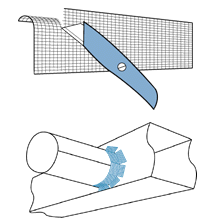
installed mastic
An enormous waste of energy occurs when cooled air escapes from supply ducts or when hot attic air leaks into return ducts. Recent studies indicate that 10 percent to 30 percent of the conditioned air in an average central air conditioning system escapes from the ducts.
For central air conditioning to be efficient, ducts must be airtight. Hiring a competent professional service technician to detect and correct duct leaks is a good investment, since leaky ducts may be difficult to find without experience and test equipment. Ducts must be sealed with duct "mastic." The old standby of duct tape is ineffective for sealing ducts.
Obstructions can impair the efficiency of a duct system almost as much as leaks. You should be careful not to obstruct the flow of air from supply or return registers with furniture, drapes or tightly fitted interior doors. Dirty filters and clogged evaporator coils can also be major obstructions to air flow.
The large temperature difference between attics and ducts makes heat conduction through ducts almost as big a problem as air leakage and obstructions. Ducts in attics should be insulated heavily in addition to being made airtight.
Buying New Air Conditioners
Today's best air conditioners use 30 percent to 50 percent less energy to produce the same amount of cooling as air conditioners made in the mid 1970s. Even if your air conditioner is only ten years old, you may save 20 percent to 40 percent of your cooling energy costs by replacing it with a newer, more efficient model.

- Sizing Air Conditioners
Air conditioners are rated by the number of British thermal units of heat they can remove per hour. Another common rating term for air conditioning size is the "ton," which is 12,000 British thermal units per hour.
How big should your air conditioner be? The size of an air conditioner depends on:
- how large your home is and how many windows it has;
- how much shade is on your home's windows, walls and roof;
- how much insulation is in your home's ceiling and walls;
- how much air leaks into your home from the outside; and
- how much heat the occupants and appliances in your home generate.
An air conditioner's efficiency, performance, durability and initial cost depend on matching its size to the above factors.
Make sure you buy the correct size of air conditioner. Two groups — the Air Conditioning Contractors of America and the American Society of Heating, Refrigerating, and Air Conditioning Engineers — publish calculation procedures for sizing central air conditioners. Reputable air conditioning contractors will use one of these procedures, often performed with the aid of a computer, to size your new central air conditioner.
Be aware that a large air conditioner will not provide the best cooling. Buying an oversized air conditioner penalizes you in the following ways:
- It costs more to buy a larger air conditioner than you need.
- The larger-than-necessary air conditioner cycles on and off more frequently, reducing its efficiency. Frequent cycling makes indoor temperatures fluctuate more and results in a less comfortable environment. Frequent cycling also inhibits moisture removal. In humid climates, removing moisture is essential for acceptable comfort. In addition, this cycling wears out the compressor and electrical parts more rapidly.
- A larger air conditioner uses more electricity and creates added demands on electrical generation and delivery systems.
Air Conditioner Efficiency
Each air conditioner has an energy-efficiency rating that lists how many British thermal units per hour are removed for each watt of power it draws. For room air conditioners, this efficiency rating is the Energy Efficiency Ratio, or EER. For central air conditioners, it is the Seasonal Energy Efficiency Ratio, or SEER. These ratings are posted on an Energy Guide Label, which must be conspicuously attached to all new air conditioners. Many air conditioner manufacturers are participants in the voluntary EnergyStar® labeling program. EnergyStar-labeled appliances mean that they have high EER and SEER ratings.
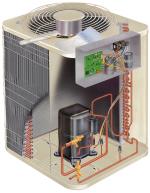
central air conditioner
In general, new air conditioners with higher EERs or SEERs sport higher price tags. However, the higher initial cost of an energy-efficient model will be repaid to you several times during its life span. The Energy Office offers 5% Dollar and Energy Saving Loans through local participating lenders for the purchase of high efficiency air conditioners. Buy the most efficient air conditioner you can afford, especially if you use an air conditioner frequently.
- Room Air Conditioners — EER
Room air conditioners generally range from 5,500 to 14,000 British thermal units per hour. National appliance standards require room air conditioners built after January 1, 1990, to have an EER of 8.0 or greater. In Nebraska, the Energy Office recommends a room air conditioner with an EER of at least 10.0. The Association of Home Appliance Manufacturers reports that the average EER of room air conditioners rose 47% from 1972 to 1991. If you own a 1970s-vintage room air conditioner with an EER of 5 and you replace it with a new one with an EER of 10, you will cut your air conditioning energy costs in half.
- Central Air Conditioners — SEER
National minimum standards for central air conditioners require a SEER of 9.7 and 10.0, for single-package and split-systems, respectively. But you do not need to settle for the minimum standard. There is a wide selection of units with SEERs reaching nearly 17. In Nebraska, the Energy Office recommends the purchase of a unit with a least of SEER of 12.0. Before 1979, the SEERs of central air conditioners ranged from 4.5 to 8.0. Replacing a 1970s-era central air conditioner with a SEER of 6 with a new unit having a SEER of 12 will cut your air conditioning costs in half.
Hiring Professional Service
When your air conditioner needs more than the regular maintenance described previously, hire a professional service technician. A well-trained technician will find and fix problems in your air conditioning system. However, not all service technicians are competent. Incompetent service technicians forsake proper diagnosis and perform only minimal stop-gap measures. Insist that the technician:
- check for correct amount of refrigerant;
- test for refrigerant leaks using a leak detector;
- capture any refrigerant that must be evacuated from the system, instead of illegally releasing it to the atmosphere;
- check for and seal duct leakage in central systems;
- measure air flow through the evaporator coil;
- verify the correct electric control sequence and make sure that the heating system and cooling system cannot operate simultaneously;
- inspect electric terminals, clean and tighten connections and apply a non-conductive coating if necessary;
- oil motors and check belts for tightness and wear; and
- check the accuracy of the thermostat.
Choosing a Contractor
Choosing a contractor may be the most important and difficult task in buying a new central air conditioning system. Ask prospective contractors for recent references. If you are replacing your central air conditioner, tell your contractor what you liked and did not like about the old system. If the system failed, ask the contractor to find out why. The best time to fix existing problems is when a new system is being installed.
When designing your new air conditioning system, the contractor you choose should:
- use a computer program or written calculation procedure to size the air conditioner;
- provide a written contract listing the main points of your installation that includes the results of the cooling load calculation;
- give you a written warranty on equipment and workmanship; and
- allow you to hold the final payment until you are satisfied with the new system.
Avoid making your decision solely on the basis of price. The quality of the installation should be your highest priority, because quality will determine energy cost, comfort and durability.
Installation and Location of Air Conditioners
If your air conditioner is installed correctly, or if major installation problems are found and fixed, it will perform efficiently for years with only minor routine maintenance. However, many air conditioners are not installed correctly. As an unfortunate result, modern energy-efficient air conditioners can perform almost as poorly as older inefficient models.
Be sure that your contractor performs the following procedures when installing a new central air conditioning system:
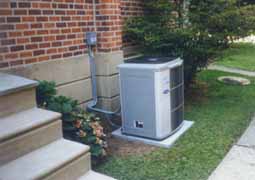
- allows adequate indoor space for the installation, maintenance and repair of the new system, and installs an access door in the furnace or duct to provide a way to clean the evaporator coil.
- uses a duct-sizing methodology such as the Air Conditioning Contractors of America Manual D.
- ensures there are enough supply registers to deliver cool air and enough return air registers to carry warm house air back to the air conditioner.
- installs duct work within the conditioned space, not in the attic, wherever possible.
- seals all ducts with duct mastic and heavily insulates attic ducts.
- locates the condensing unit where its noise will not keep you or your neighbors awake at night, if possible.
- places the condensing unit in a shady spot, if possible, which can reduce your air conditioning costs by 1-2 percent.
- verifies that the newly installed air conditioner has the exact refrigerant charge and air flow rate specified by the manufacturer.
- locates the thermostat away from heat sources, such as windows, or supply registers.
If you are replacing an older or failed split system, be sure that the evaporator coil is replaced with a new one that exactly matches the condenser coil in the new condensing unit. The air conditioner's efficiency will likely not improve if the existing evaporator coil is left in place. Iin fact, the old coil could cause the new compressor to fail prematurely.
If you install a new room air conditioner, try to:
- locate the air conditioner in a window or wall area near the center of the room and on the shadiest side of the house.
- minimize air leakage by fitting the room air conditioner snugly into its opening and sealing gaps with a foam weatherstripping material.
Paying attention to your air conditioning system saves you money and reduces environmental pollution. Notice whether your existing system is running properly, and maintain it regularly. Or, if you need to purchase a new air conditioner, be sure it is sized and installed correctly and has a good EER or SEER rating.
Using Your Air Conditioner
An air conditioner will cool the air in your home fairly quickly. For economical operation, turn it on only when your home is occupied. You may consider installing a programmable thermostat. These allow you to set the time when the air conditioner will turn on, such as 30 minutes before you arrive home from work on a hot day. During the day, keep the drapes or blinds closed on windows that face east, south, and west. This will help reduce solar heat gain into your home.